Marketing for Breakfast - Past Sessions
How about a little bite?
Members receive a complimentary breakfast delivered to their door, perfectly prepared for the session. So, sit back, relax, and get your marketing hat on as we bring the event straight to you.

A Guide to Automation – Ben Geddes
In our Marketing Automation session, Ben Geddes gave us an intricate guide to what you need to deliver automated marketing, what to focus on and how you can deliver game-changing results, whatever your budget.
Ben identified the four pillars of marketing automation –
Technology: With over 15,000 martech tools available, selecting the right one depends on your budget, industry, and CRM maturity. Ease of use and integration are key.
Data: Reliable and rich customer data is essential. Even basic tools can be powerful if the data is accurate.
Content: Content must be relevant and tailored to the audience. Generic content won’t cut it.
People: Skilled staff are crucial to manage and optimise automation. Automation is not just ‘set and forget’—it requires ongoing attention.
The Key Opportunities
Every business is different, but there are some key opportunities that will apply to most. Focus on these and you’ll typically see the biggest results.
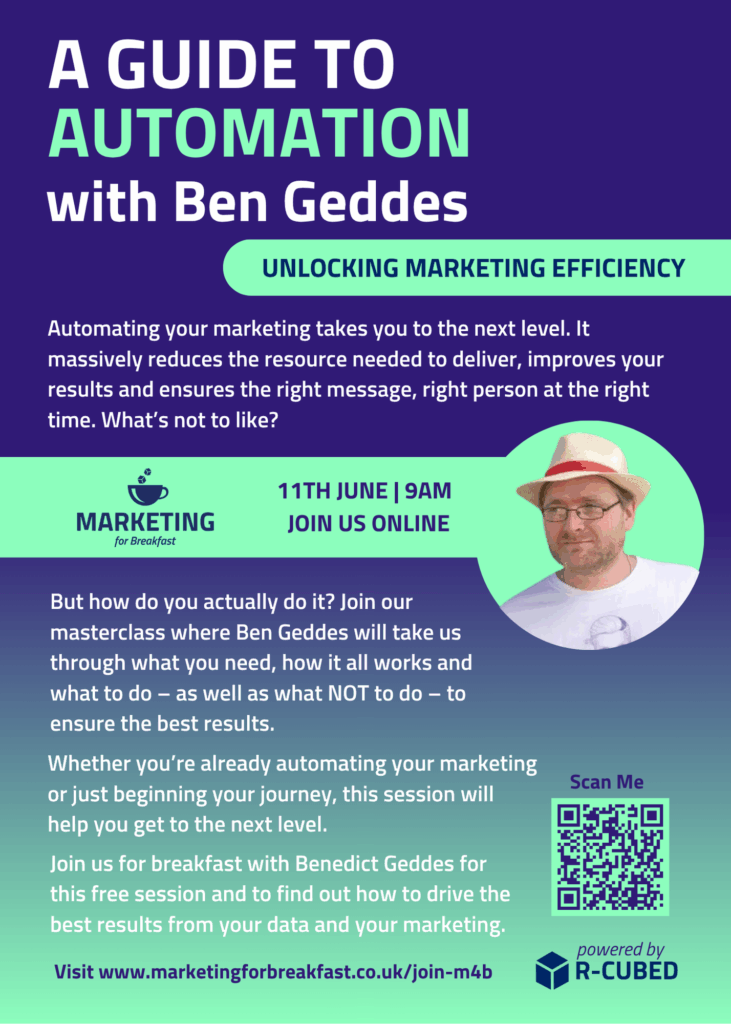
Abandoned Cart Emails – follow up those pending sales
Welcome comms – build trust and engagement early with new customers.
Previous Purchase Triggers – Use purchase history to predict and prompt future buying behaviour.
Retargeting: Share customer data with PPC and social teams to improve ad efficiency.
Segmentation and Dynamic Content – serve personalised content based on interests.
Continual testing – Automate A/B testing and refine your comms for continuous improvement.
Marketing automation is a blend of technology, data, content, and people. The most successful programs are those that are continuously optimised. Start with the basics, automate the routine, and build toward more complex journeys. With the right strategy and execution, marketing automation can deliver substantial long-term value.
Want to see the full pack from the session, packed with more details and practical examples?
Download it for free here…
The Power of First Party Data – James Alty
James Alty, MD of Apteco, led an in-depth discussion about how you should be using your first-party data to greatest effect. James is an expert in his field and talked about how, as marketers, we have so much data at our fingertips, but have a responsibility to use it, not just profitably, but also with care and respect.
So what did we learn?
- First party data is the most valuable data you have, as you’ve collected it directly from the customer. But don’t think that you need a customer name for first party data. You may have anonymous data (eg device data) that you have no name for, but you have a great picture of what they are interested in, what times they browse and other key indicators. So you can still send targeted, personalised messages, even without a name.

- Use your first party data to hyper-personalise your messaging – aim for 1-2-1 communications that are meaningful and relevant. But, at the same time, don’t over-do it. Too much personalisation gets creepy and you don’t want to come across as a stalker.
- Create customer segments to understand their relative value. But go beyond that and use the data to monitor movement between segments – and then learn to predict it, to nurture your customers and prevent attrition.
- Automate your processes wherever you can. You’ll never have the resource to manually process all that data and deliver the campaigns that you need. So research your martech and make sure it fits your needs.
- Understand your privacy policy and permissions. Your data has limited use if you haven’t collected it in line with data protection regulations, or you don’t have appropriate permissions for the customers, whether that’s consent, legitimate interest or some other basis. So understand your own privacy policy, fine tune it and make sure you’re not breaking the rules.
- Use AI to improve your customer understanding and innovate your campaigns. AI is far more than using ChatGPT to write your copy. If you use the right tools, you can use it to understand your customers and create new strategies. But not all AIs are the same and they won’t all handle your data and crunch the numbers reliably. And remember to check, check and check the output again.
”You need to think of AI like an intern. Super enthusiastic, very helpful. Always there, but sometimes gets things wrong.”
Want to know more about first party data, how to extract the maximum value from it and the martech you need to make it all happen?
Drop us a line at R-cubed and let’s talk.
Customer Outcomes – Olaf Gueldner
Not all sales are equal. Some deliver short-term profit, while others build long-term value.
In our latest Marketing for Breakfast webinar, we had the pleasure of hosting Olaf Gueldner, who shared invaluable insights on transforming customer experiences and driving profitability. Here’s a summary of the key points discussed:
Understanding profitable customers
Olaf emphasised the importance of identifying both current and future profitable customers. Knowing where your profit comes from is crucial for strategic planning.
Addressing customer pain-points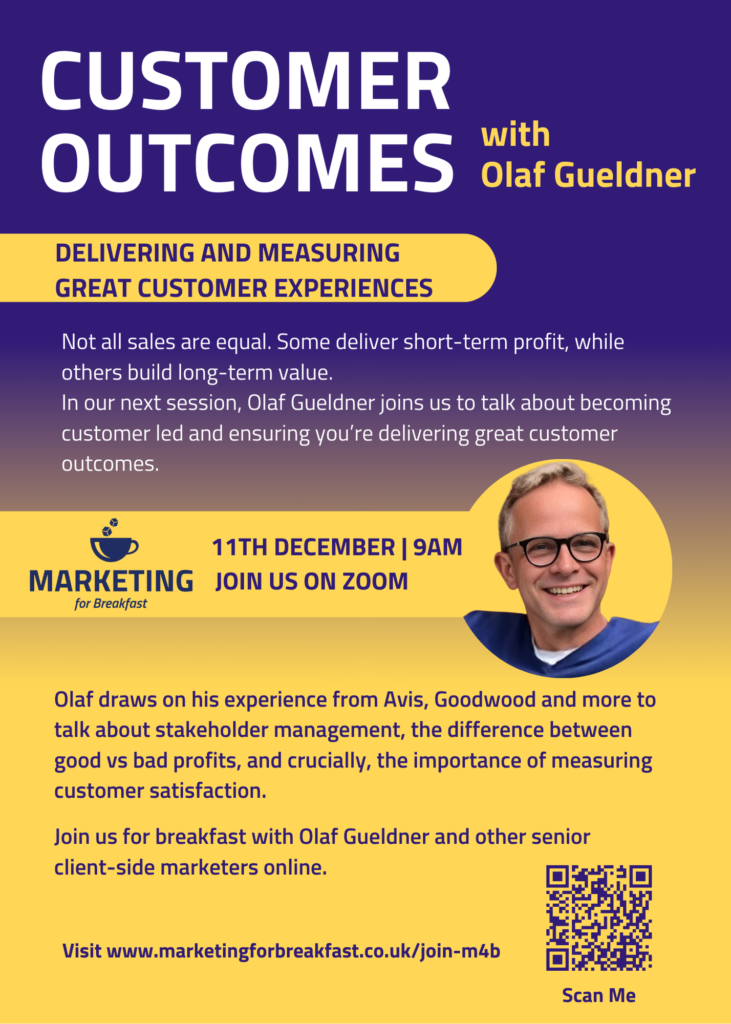
Understand what customers like and dislike, including their opinions on competitors. Olaf recommended starting with qualitative focus groups before moving to quantitative research.
Make your offerings easy to navigate
When Olaf joined car rental giant Avis, their cars were listed A-Z, which was of little benefit to customers looking for a choice of cars suitable for four passengers and luggage.
Reorganising this into small, medium and large matched customer needs far better and made the buying experience easier.
Gaining buy-In for changes
Introducing changes within a business requires a mix of short-term wins and long-term commitment. This can be particularly challenging if your staff have been with the business for a long time and are used to doing things in a certain way.
Get a few key people on board and use them as an example to influence others.
Defining good and bad profit
Where are your profits coming from? Good profit comes from customers having a positive experience and being willing to pay more. On the other hand, bad profit is made when customers have a negative experience. Yet each type has a different impact on future customer behaviour.
Enhancing the customer experience
It’s vital to fix customer service issues before addressing product problems. Olaf highlighted the importance of being fully invested in customer service to demonstrate that you ‘walk the talk’.
Net Promoter Score (NPS) and its impact on profit
Understanding NPS
NPS is a key metric for gauging customer satisfaction. Asking “How likely are you to recommend this event/product to others?” identifies your promoters (scores 9-10), neutrals (score 8), and detractors (scores 7 and below). But most companies fail to make use of that data beyond the top-line number. If you apply it to each customer record, you build up a far richer picture of customer value.
Impact on repeat purchases
Higher NPS scores often correlates with higher repeat purchases. And addressing issues can result in a higher NPS more than if everything went smoothly initially.
Improving NPS
Olaf shared that comparing NPS to offline data can help target improvements. Incentivising referrals and addressing low ratings can positively influence NPS. Timing is also crucial; do you want immediate feedback, or to give the customer some time to assess their purchase?
Olaf’s insights provided a comprehensive look at how businesses can transform customer experiences and drive profitability.
If you missed the session, look out for content from the session on our LinkedIn page here: Marketing for Breakfast LinkedIn page
Becoming a ‘Customer First’ Business with Alex Bannister
Most companies say they’re member-oriented or ‘customer first’, but how many really are?

Alex Bannister led our May session of Marketing for Breakfast with his extensive knowledge of customer-focused actions.
Having spent 26 years at Nationwide in various roles, he helped to deliver better outcomes for the building society’s members, through better insights and analysis.
Alex ensured that everyone in the business had access to the customer data they needed, from the boardroom to the high street branches.
This session had a massive turnout from a range of industries, including financial services. Alex talked about:
- Focusing business actions for the customer
- The technology and operational issues that will need to be solved
- Future proofing your marketing actions
- Using advanced analytics to unlock the best marketing actions available
- Personalising marketing communications for each customer
- The common roadblocks in your customer-first journey.
It’s not just about marketing, but about delivering greater effectiveness throughout the business – whether that be through call centres, stores or other head office functions.
If you missed the session, look out for content from the session on our LinkedIn page here: Marketing for Breakfast LinkedIn page
Brand Architecture with Dean Harvey
In this session, we delved into the world of branding. Where do you start? What does your brand stand for? And who should be in charge of it? Here’s what we learned…
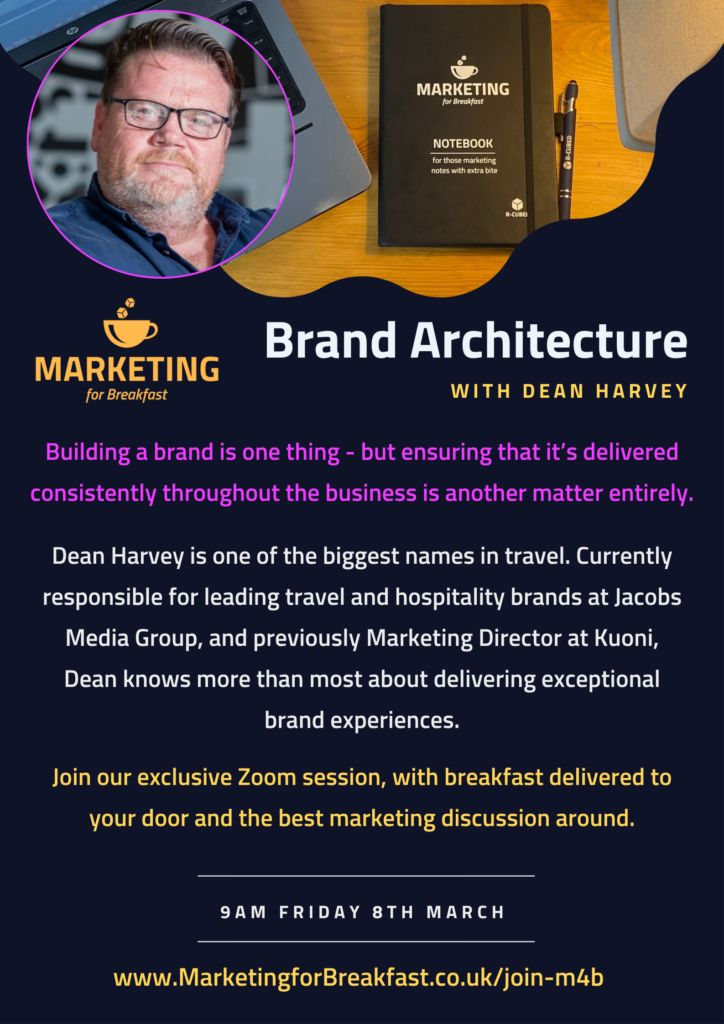
Brand ownership was a key discussion point. Everyone fancies themselves as a marketeer, from the CEO downwards, but you need to ensure your brand isn’t a vanity project. Be honest about what you stand for, and ensure the brand represents that. Speak to your customers, get an independent viewpoint and – most importantly – be prepared to listen to them.
A brand is far more than your logo and fonts. It needs to answer a simple question – why should the customer choose us? Don’t be tempted just to put a fresh coat of paint onto a product or business that doesn’t have a clear positioning.
The thorny question of how to control the execution of a brand also came up. How do you stop people across the business from doing their own thing? You might want to produce templates for everything – but this can be time consuming. Or you might empower people to do their own thing, but have regular 6-month check-ins to keep everything on track.
And a final tip – the simpler you keep your brand creative, the more likely it is to be properly implemented. So don’t make life complicated with multiple fonts and dozens of iterations of your logo!
Dean Harvey is one of the biggest names in travel. Currently responsible for leading travel and hospitality brands at Jacobs Media Group, and previously Marketing Director at Kuoni, Dean knows more than most about delivering exceptional brand experiences.
We had a great session – if you missed it, follow our LinkedIn to stay up to date with more content and new sessions here: Marketing for Breakfast LinkedIn
From the Pitch to the Boardroom with Rob Andrew
We were thrilled to be joined by the distinguished Rob Andrew as our special guest speaker. Rob Andrew, the former international rugby player, has embarked on an incredible journey from the field to the boardroom, through different sports and different businesses.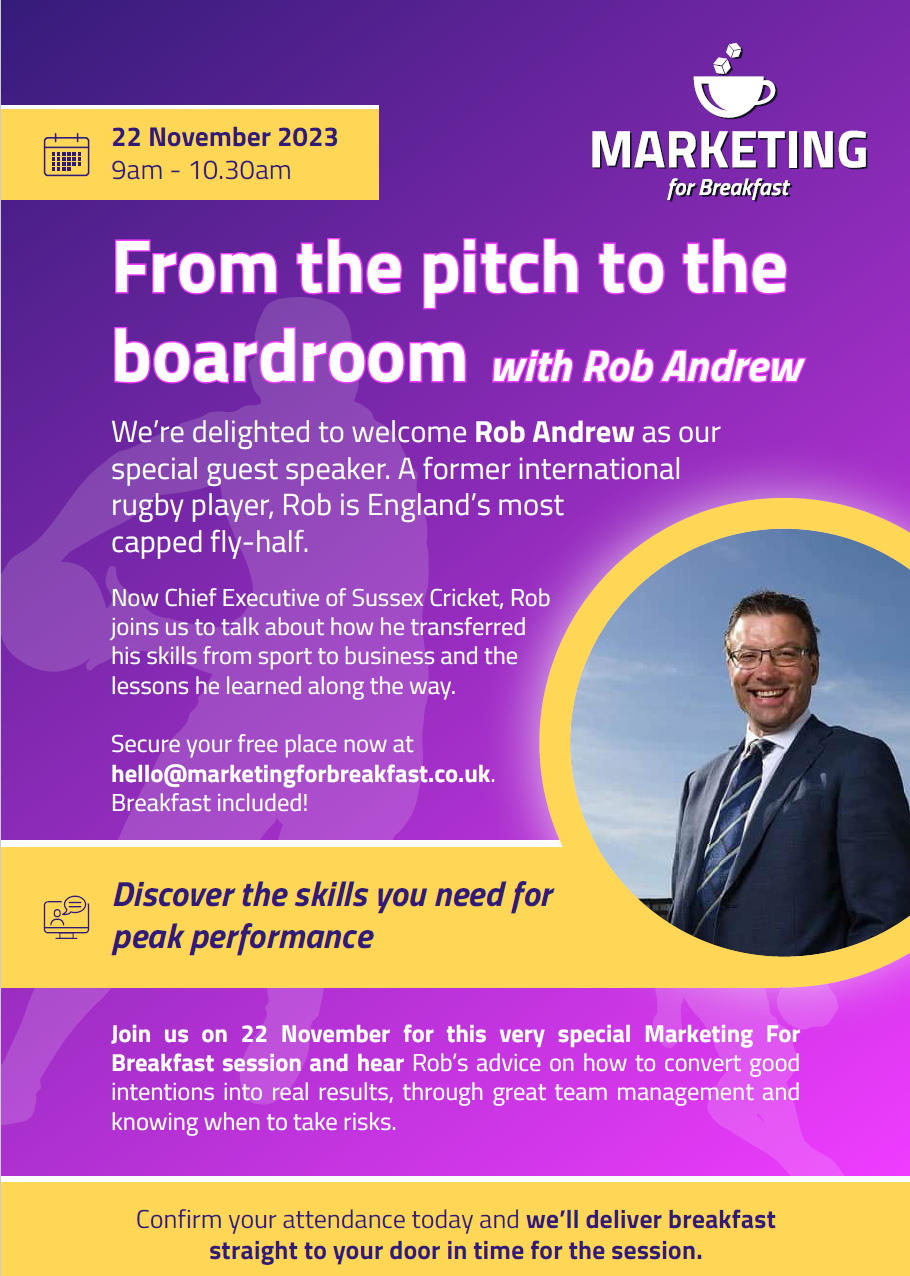
Serving as the Chief Executive of Sussex Cricket since 2017 and moving to the English and Welsh Cricket Board in 2024, Rob joined us to share his invaluable insights into how he effectively translated his sporting prowess into the world of business and the priceless lessons he has gathered along the way.
We got to speak about:
- The values and culture that are formed ‘by a winning team, for a winning team’. And how these create buy-in from your team members.
- The benefits and drawbacks of remote vs on-site working.
- Skills and behaviours to lead a successful team.
- Teamwork and team building to create an environment of trust to facilitate business actions.
More insights into the contents of our discussions are posted to our LinkedIn page, be sure to follow!
Does loyalty marketing work?
We were joined by Karen Dumbrell, a loyalty marketing expert, to discuss what loyalty really means and how to achieve it.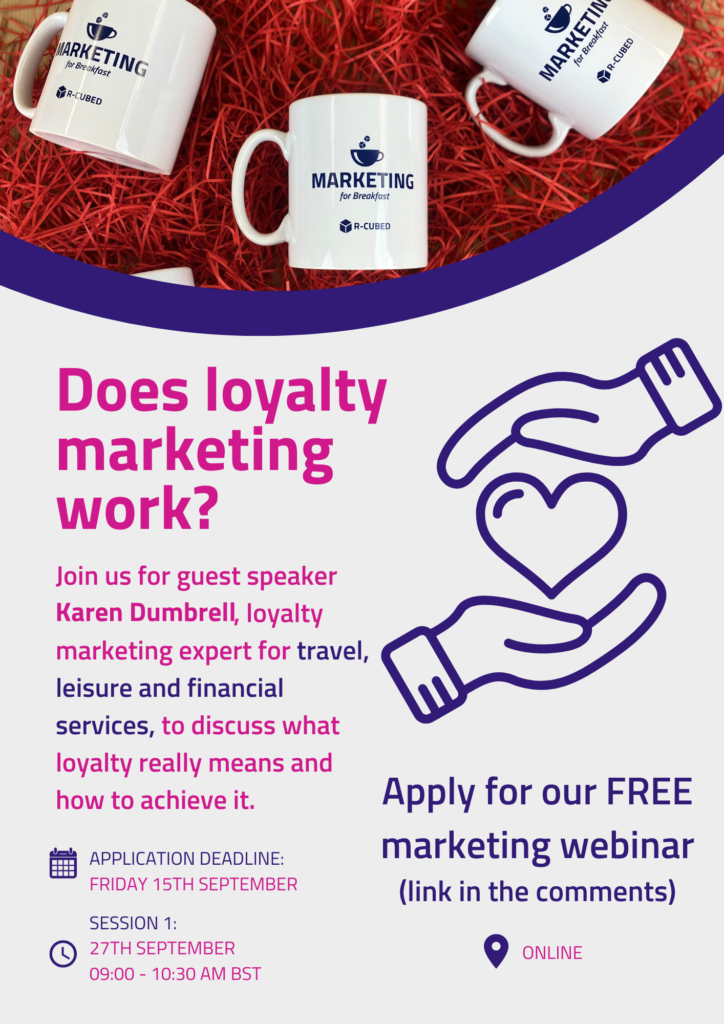
With experience across industries including travel, leisure and financial services, with big names such as Virgin Atlantic and Arsenal FC, Karen shared with us the key parts of developing a loyalty programme and getting it to stick.
We got through so much, but here are the headlines:
- We discussed the difference between membership loyalty schemes and points/reward loyalty schemes.
- Why you should have a loyalty programme.
- The 3 R’s of a loyalty programme – Rewarding, Relevant and Recognition.
- Steps to make sure your programme is working how you intend it to.
- Being confident in who your customers are and how they will interact with your loyalty scheme.
- And even how to plan an exit strategy for when you want to end your loyalty programme.
Our standout quote from Karen was that with a loyalty programme, ‘It’s all about the data!’
Social Purpose with Steve Harrison

We were delighted to be joined at this session by Steve Harrison, award-winning creative director and author of ‘Can’t Sell, Won’t Sell’.
We talked about Social Purpose-driven marketing and the role it plays in modern-day marketing. Steve’s view is clear – a marketer’s job is to sell.
The standout quote from Steve was “We used to sell to people – now we follow them around on the internet shouting at people“. It’s not to take a stance on social issues or try to change the world. But what do others think?
There was a consensus that marketing your product comes first. But many also felt an obligation for the brand to be seen as doing the right thing – especially if your customer base expresses concerns about those issues.
And of course, for some brands, it’s not a matter of a short-term commitment – certain beauty brands, for example, have social purpose embedded in their DNA. Take that away and what is the brand left with?
However, there was a concern from some members that insincere hopping onto a bandwagon by brands can dilute the impact of those brands who live it 24/7. How many brands change their logo to a rainbow-themed one in June, just to switch back in July? Is this seen as simply cashing in on a theme, does it tar all brands with the same brush?
The relevance of social purpose marketing is also going to be driven by your customer base. How important are the issues to your customers – this raised an interesting point of whether such issues are a luxury that wealthier customers can indulge in, rather than those who have to focus on price and value in their purchasing decisions.
It was a great session, which raised a lot of complex and sometimes difficult questions.
Remote working – what does it mean for your team and your customers?

We asked two questions in this session. 1) How has remote working impacted how you manage your team? 2) How has it changed the behaviour of your customers?
- When it came to managing teams in a remote working culture, one thing was clear. There is no single solution that suits everyone. Members spoke of different appetites for being at home in the office, dependent on role and personal situation.
- A number of people mentioned that there was a mixed appetite for home-working, often influenced by role and personal situation. In particular, younger employees often had a greater appetite for not being confined to the office, but ironically, they were seen as the ones who potentially had the most to lose. Participants talked about the importance of face-time with senior colleagues and how so much learning early in your career takes place from simply being around others. This led to an interesting moral question – is it fair to force new starters and younger workers to be in the office more than more established colleagues for their own benefit?
- The importance of staying connected was also brought up, especially with functions that couldn’t work from home, such as call centres. It was suggested that marketers need to improve their relationships with call centres in general as they can be your best friend – or your worst enemy – and that its more important now than ever to stay in touch.
- Customer behaviour has also changed as a result of new working patterns. Call centre traffic is now more evenly spread across the day, rather than concentrated around early morning and lunchtimes. Changes are also notable in website traffic, with many customers having more freedom to do personal tasks now they’re no longer in the office.
- There was also a feeling that direct mail was gaining in importance, with customers how on first-name terms with their postman and having more time to look through their post. This was coupled with a general consensus that email was no longer the force it used to be, due to its massive overuse by the marketing industry and that new channels were needed to provide cut-through.
Marketing Room 101
 Nominations were fast and furious, with attendees arguing for and against nominations. Here’s a few highlights –
Nominations were fast and furious, with attendees arguing for and against nominations. Here’s a few highlights –
Influencers
Talented, tech-savvy individuals who’ve taken PR to new levels in the digital age, bypassing traditional channels? Or over-paid, self-obsessed millennials who are addicted to selfies and iphones and want to be paid to simply get out of bed?
Both, according to our panel. They may just be a modern evil you have to learn to live with.
The Metaverse
What is it? Why is it? And when are we going to see some concrete evidence of it, beyond avatars being given legs? Whether you interpret the Metaverse as being the internet, cyberspace, virtual reality or all of the above, there’s a frustration that it hasn’t yet taken us into the Matrix…
Board interference
Ouch. We’ve all had it. Being over-ruled by the board. Having your carefully laid plans trampled over and your budget taken away to fund the CEO’s latest brainwave. It’s hard, it’s frustrating, but they also pay your salary.
Sometimes, you just have to grit your teeth, smile and move on.
Print production
Firstly, there’s the environmental consideration. Should we still be turning trees into mail packs? Secondly, it’s slow and expensive and if you’ve grown up in the digital world, the whole process may be a complete mystery to you.
On the other hand, it can be an devastatingly effective channel, engaging customers and also allowing for great creativity. One thing everyone agreed on, however, was that non-personalised mail was intensely annoying and generally ineffective.
And finally…
‘Everyone’s a marketer’
Every marketer will be familiar with this one. Wherever you work, you quickly find that everyone’s an expert in marketing and will tell you exactly what you should be doing. Whether it’s the CEO telling you of an idea they had, or your Aunty Doreen telling you that no-one reads direct mail and you should only ever advertise during Coronation Street.
It’s probably best to just nod politely and ignore them.
Oh, and resist the temptation to knock on the Finance Director’s door and tell him about your new idea of how to add up numbers.
“It’s a great opportunity to take some time out to talk about key issues with other marketers”
Next Event - Next event coming soon
Looking for what’s coming next?
Check back soon to find out when our next Marketing for Breakfast event will be.
In the meantime… we’ve got a dedicated LinkedIn page which you can follow here to get notified when our next session is announced.
